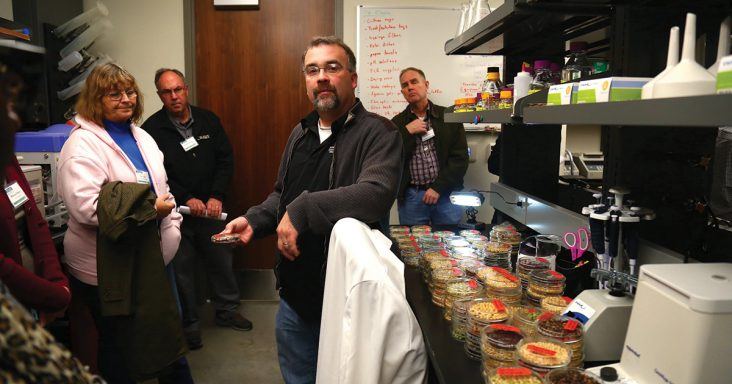Scientists trying to find ways to stop mycotoxins in crops, commodities
by December 29, 2019 9:18 pm 924 views

Burt Bluhm (center), associate professor of plant pathology for the University of Arkansas, with staff at his Mycotoxin and See Borne Disease Research Lab.
The United States is the top food exporter in the world, and scientists are constantly studying ways to protect the ag sector from the field and into the storage bins that hold crops, according to the University of Arkansas System Division of Agriculture.
Mycotoxins, a family of toxins generated by fungi attacking grains, nuts and other foods and commodities, impact public health and international trade. Researchers at the UA are leading some of the world’s most cutting-edge efforts to stop the prevalent toxins.
Burt Bluhm, associate professor of plant pathology for the University of Arkansas, is primary investigator and director of the Mycotoxin and Seed Borne Disease Research Lab. After operating out of the Rosen Alternative Pest Control Center on the UA Fayetteville main campus, the lab relocated in 2018 to the newly-constructed Don Tyson Center for Agricultural Sciences, several miles north.
Bluhm said that mycotoxins, while pervasive, are still relatively unstudied, compared to other dangers faced by producers.
“Mycotoxins in particular have been overlooked in some corners of the research world,” Bluhm said. “There are a lot of reasons for that. In some ways, especially in corn, and in the United States, it’s historically been perceived as a ‘Southern problem.’ Mycotoxins haven’t been as common in the big corn-producing states through the Midwest.”
Countries worldwide try to minimize an influx of foods that have these fungi. The European Union has stringent intolerances for the presence of mycotoxins in any grain shipment, especially imports, leading to the rejection of exports that would otherwise meet or exceed safety standards at the point of origin. In other areas of the world dealing with elevated food scarcity, mycotoxins are sometimes tied to severe illness.
“For the E.U., it’s primarily a trade issue,” Bluhm said. “But in developing nations in Asia and Africa, mycotoxins are a more serious problem. Where food security is an issue, where people have to eat whatever’s available, if the food is contaminated with mycotoxins, you’ll see outbreaks of extreme illness and death.”
Mycotoxins are a family of toxins created when fungi feed on grain, either during the growing season, or when grain has been improperly stored. The fungi feed off the available carbohydrates, then secrete toxins into the colonized grain. In addition to corn, mycotoxins are found in other grains, tree nuts and cotton. There is a concern, Bluhm said, about possible mycotoxins in rice.
“There are really two issues at play,” Bluhm said. “One is that ‘a little bit of mycotoxin goes a long way,’ so to speak. So even if you have a low percentage of infected kernels, the ‘mycotoxin-per-kernel’ can be very high. So at the level of a truckload, when that grain is eventually homogenized, even a relatively low incidence of infection can lead to serious problems.”
Mycotoxins are relatively stable, and can easily survive the food making process, according to the World Health Organization. These fungi can cause liver damage, several types of cancers, kidney damage, can compromise a consumer’s immune system, and ingestion in some cases can lead to death, the World Health Organization reported. The fungi can be visible to the naked eye in the form of mold, but often it goes undetected.
Bluhm received his training in pathology, and mycotoxins specifically, at Purdue University in Indiana. When he arrived in Arkansas, he said, it was clear that the problem was more widespread in the state’s (and the region’s) corn crops that he had realized.
Over the past decade, Bluhm’s lab has worked to map the genetic layout of the 20-30 fungi involved in creating mycotoxins around the world, searching for specific weaknesses to attack. The lab is also working to develop biological control agents to combat mycotoxins.
“In some cases, if you apply a non-toxigenic strain of a species like you would a fungicide or insecticide, you overwhelm the fungus with that nontoxic cousin of what’s naturally out there,” Bluhm said. “It can be very effective.”
In October, the Division of Agriculture hosted the annual conference of the Council for Agricultural Science and Technology, commonly known as CAST. More than 70 representatives of academic, legal, governmental and other institutions attended the 2019 Annual Fall Board Meeting, touring facilities and projects chosen to highlight the university’s efforts and contributions to modern agriculture.
Dr. Mark Cochran, vice president for agriculture for the University of Arkansas System, said he selected Bluhm’s lab for conference attendees to tour because, in addition to the lab being fundamentally important to international food safety, it also speaks to CAST’s concerns regarding the advancement of science and technology within the world of agriculture.
“We tried to match our expertise with some of the issues CAST is addressing,” Cochran said. “CAST is organized into animal, plant and food working groups. A lot of the more complex issues are going to transcend all three of those areas.”
Cochran also noted that Bluhm has been broadly recognized for his work as a molecular pathologist with particular expertise in mycotoxins of grain, Cercospora diseases of corn and soybeans, and the development of novel approaches for disease control.
“His approaches have included molecular genetics, gene editing and the use of RNA interference,” Cochran said. “His research has been supported by several nationally competitive grants.”
